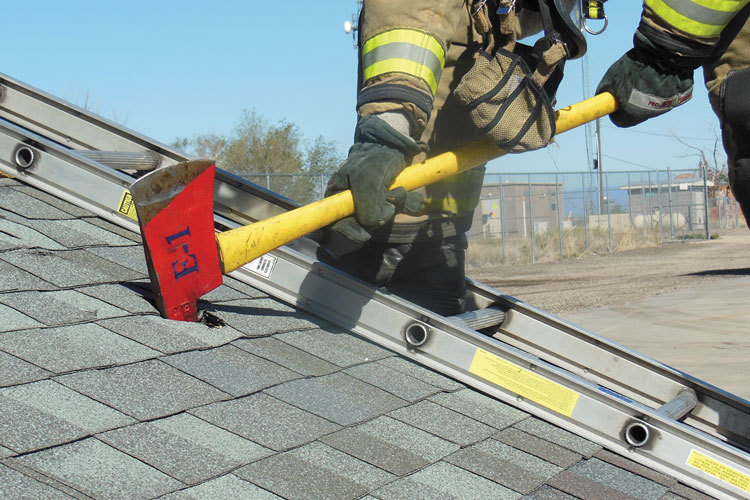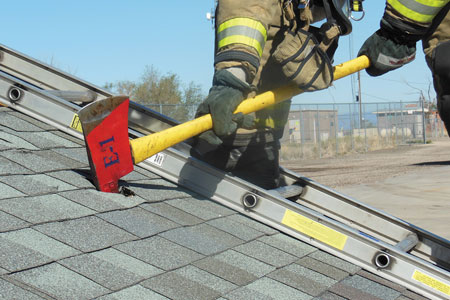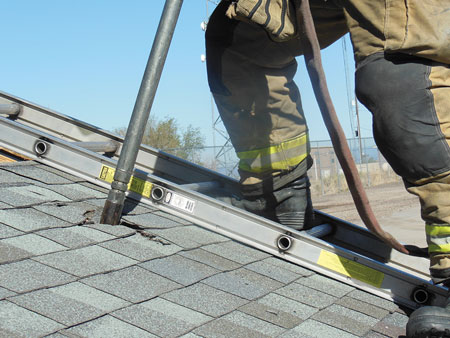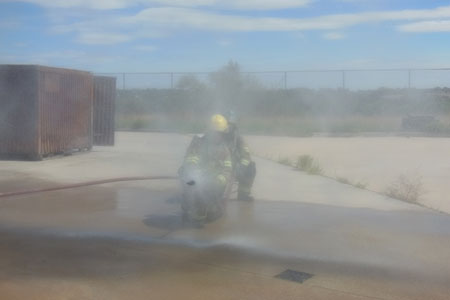
by BILL NEMICK
Nearly 20 years ago, as a young company officer, I responded to a fire that was nearly disastrous for my crew and me. Now referred to as a “near miss,” this fire forever changed my outlook on attic fires and ultimately led to my adoption of the piercing nozzle technique. That night, a fire had started in a second-story apartment in an older, eight-unit building. The first-in engine company attacked the fire and seemed to have extinguished it without issue.
I was the company officer on the second attack line, and the only thing we encountered when we entered the building was light smoke. While we were overhauling, we noticed that it was getting uncomfortably hot. At first, I attributed the temperature increase to the length of time we had been in the building, rationalizing that the heat was finally permeating our bunker gear. As we continued to overhaul, the incident commander (IC) reported that there was still a considerable amount of smoke exiting from the roof eaves. In that moment, I realized there must have been a sizable fire in the attic directly above us.
 |
| (1) Using a pickhead ax, make a hole in a roof. (Photos by author.) |
My team tried frantically to pull the ceiling with the hand tools we had, but we did not have a pike pole to effectively pull down the lath and plaster ceiling. I radioed the IC immediately and requested a crew with pike poles. They arrived in just a minute or two – though it seemed much longer – and they pulled a hole in the ceiling. By this time, the smoke and heat conditions drastically worsened and, when the crew had made a hole large enough to direct a fire stream through, the smoke and heat forcefully pushed down and out of the attic, enveloping us in total darkness. I opened the nozzle and directed it toward the ceiling. The only way I was able to determine when the stream was going into the attic space was when I couldn’t hear the stream bouncing off the ceiling. In that same moment, I felt a burning sensation around my wrists and along the sides of my face; the steam was burning us.
Moments later, we heard a loud crash that was followed by the sound of air horns warning us to evacuate immediately. We followed the hoseline out. Once outside, we learned that the roof had collapsed on us; only the stout ceiling rafters prevented the roof from crushing us.
This experience shook me up, and I vowed to never again enter a structure fire without a pike pole and to always check the attic for extension as soon as possible. More broadly, I vowed to become better at fighting attic fires by educating myself and by training on the traditional techniques used to fight attic fires. Though I learned the traditional techniques well, I never was quite satisfied with them; they had too many variables and required precise coordination between firefighting teams to succeed. I believed that there must be a better way to prevent and combat attic fires.
Coordinating Ventilation
The technique I trained with was remarkably similar to the basic technique I had learned as a rookie some 30 years ago. The basic technique is as follows: The engine company advances an attack line into the house and prepares to pull the ceiling; at the same time, the truck company ladders the building and prepares to cut a large hole in the roof. As soon as the hole in the roof is complete, the engine company pulls the ceiling and applies water into the attic space. When done properly, the hole in the roof will vertically ventilate the house while also allowing the steam generated by the hose stream to escape. This tactic works well as long as everything is precisely coordinated. The problem is to coordinate everything as a dynamic situation unfolds; circumstances always seem to change just enough to throw off the timing.
 |
| (2) Insert the piercing nozzle (3) all the way into the attic space to maximize effectiveness. |
In theory, this tactic is sound. In reality, the desired outcome is difficult to achieve. In particular, the problem with this tactic rests with the difficulty of coordinating the engine company and the truck company operations so precisely. If the truck company finishes cutting the hole in the roof before the engine company is ready, the ventilation hole will quickly turn into a raging torch. Conversely, if the engine company pulls the ceiling before the hole in the roof is finished, the smoke and fire gases will forcefully push into the living space and make the interior conditions considerably worse.
For many years now, I have struggled to make this tactic more reliable, often thinking that everything would be great if I could just improve on this or that aspect. But I was never quite able to make this tactic reliable enough for my liking. Then, by chance, I attended a class that gave me a fresh perspective not only on how to extinguish attic fires but also how to prevent some of them from occurring while on scene.
The Piercing Nozzle
The tactic incorporates the use of a piercing nozzle. At the time of this class, I knew my department had a piercing nozzle somewhere. I just didn’t know where. The only time I could remember using it was at a dump fire but never at a structure fire. To use the piercing nozzle on an attic fire, the instructor suggested making a hole in the roof with a pickhead ax and then inserting the nozzle in the hole to discharge water for 15 to 30 seconds. The logic the instructor used seemed reasonable. He said that by injecting water into a fire environment that was in a closed container (the attic), the water would quickly be converted into steam. The rapid expansion of the water would extinguish the fire. Moreover, when the water turned into steam, the pressure inside the container would increase, thereby forcing the steam into cracks and crevices to help extinguish any smoldering fires. The only reason not to use this tactic is when there is viable life inside, which is rarely the case in an attic.
I didn’t have to wait long before I had the opportunity to try out this new tactic. Within a week of the class, my division responded to a fire in the attic of a detached garage. We approached this fire using our standard procedure with a single exception: The truck company laddered the garage and was equipped with a piercing nozzle. Instead of cutting a hole in the roof the usual way, I had them make a hole using the ax’s pickhead, insert the nozzle in the hole, and flow water for about 30 seconds. This brief application of water changed the color of the smoke from black to light gray almost instantly. The fire was completely put under control without pulling any part of the ceiling or cutting a ventilation hole. I was so impressed with the results that I started providing my crews with in-depth training on piercing nozzle tactics.
 |
| (2) Insert the piercing nozzle (3) all the way into the attic space to maximize effectiveness. |
A couple of months later, we had the occasion to handle another attic fire with our new training, and it worked just as well as it did the first time. In this particular house fire, the fire started along the inside of the back wall of the structure and then spread up through the wall and into the attic. The initial attack crew entered the front door and rapidly advanced to the back room. It seemed as though they had extinguished the fire. The crew even pulled a small hole in the ceiling and discharged some water into the attic.
During this operation, I noticed smoke exiting from the eaves around the entire house; so, as a precaution, I had a crew ladder the roof and bring a piercing nozzle. Once again, I ordered the crew to make a hole with the pickhead ax near the front of the house – where they initially stepped onto the roof – insert it and then flow the nozzle for about 30 seconds. Soon after, I had them advance about 15 feet and repeat the procedure; they continued this process until they reached the back of the house.
As with the previous attic fire, I noticed a dramatic improvement in the color of smoke exiting from the eaves. After the fire was out, and during the cause-and-origin investigation, we noticed some light charring throughout the attic. It was obvious that there was fire throughout the attic space. Had we not used the piercing nozzle, we would have lost the entire house.
 |
| (4) A piercing nozzle spray pattern demonstration using a roof and attic space prop and an end view of the spray pattern. |
Since then, I have used this piercing nozzle tactic at a number of attic fires, each of which resulted in success, so much so that I now rarely order the truck crew to cut a ventilation hole in a roof. In fact, I have come to the point where I will use this piercing nozzle tactic in situations in which the fire may not already be in the attic but is likely to spread there if not quickly extinguished. I regularly have crews penetrate concealed spaces such as pipe chases, behind knee walls in finished half stories, and attic spaces if I think there is a reasonable chance that a significant fire is burning there or will be in a short time. Under such circumstances, I can justify this preventive measure because the physical damage to the roof and water damage inside are minimal if the tactic is done correctly.
Appropriate Application
However effective this piercing nozzle tactic may be, it is not indicated for all attic fires. For example, for a small smoldering fire caused by an electrical short, precision pike pole work is more appropriate. On the other end of the spectrum, for a large fire that has greatly weakened the roof, defensive firefighting tactics are the better way. Simply put, the window of opportunity to use a piercing nozzle effectively is when the time to act is short but before the structure is unsafe to enter. As always, good judgment and continued size-up of the structure’s exterior and interior are needed for safe, effective firefighting. Remember that the piercing nozzle adds another valuable tool to the firefighter’s toolbox, but ultimately it is up to the firefighter to use the right tool for the right job.
The Best Technique
To date, I have found the best technique for deploying the piercing nozzle is to make a hole with the pick end of a pickhead ax first. This usually takes several blows in the same area to enlarge the initial hole. When the hole is large enough, simply insert the piercing nozzle and open the nozzle for 15 to 30 seconds, all while moving the nozzle with an up-and-down motion. This up-and-down motion aids in spraying water around obstructions such as interior framing members (photos 1-5). After 15 to 30 seconds, make another hole about 15 feet away, and repeat the process. Continue repeating this procedure until the fire is out or at least until you reach the end of the building. When it’s too dangerous to be working directly on a roof, consider working from an aerial ladder or penetrating the gable end of the structure (photo 6).
Even though piercing nozzles are made to be driven into materials with a sledgehammer, it is quite awkward to drive a three-foot piercing nozzle through a roof with a sledgehammer, especially on a pitched roof! It’s much easier to make the hole first and then insert the nozzle. Until there is a striking tool that makes a large enough hole with one blow, the pickhead ax works sufficiently well. A striking tool with a larger pick on one side and a sledgehammer head on the other side would be ideal for this purpose.
 |
| A piercing nozzle spray pattern demonstration using a roof and attic space prop and (5) an end view of the spray pattern. |
Some situations that are ideally suited for piercing nozzle use include when it’s very difficult to pull the ceiling, such as when the ceiling is made of thick lath and plaster or has a tongue-and-groove wooden covering. Pulling a ceiling in these cases can waste precious time, giving the fire a chance to rapidly grow, whereas you can quickly insert the piercing nozzle into the attic space and extinguish the fire. Keep in mind that some ceiling may still have to be pulled for a thorough overhaul.
Piercing nozzles are also very effective on houses that have hidden voids created by home alterations. It is common to build a “new” roof over an existing one, creating a hidden void that is very difficult to detect visually. You can often find these and other hidden voids with the aid of a piercing nozzle. If you can’t fully extend the piercing nozzle through the outer roof and into the attic space, it may be that the piercing nozzle’s tip has come in contact with the old inner roof. To penetrate this inner roof and the void, you must use a sledgehammer or a flathead ax to drive the piercing nozzle through the inner roof.
To attack hidden void fires in an attic another way, first extinguish the outer void fire with a piercing nozzle and then pull the ceiling from below to expose and extinguish the fire in the inner void. In such incidents, you need a one-two punch.
 |
| (6) Deploying the piercing nozzle from an aerial ladder. |
The use of piercing nozzles is not limited to combating attic fires from the roof; piercing nozzles can be very effective in fighting basement fires as well. Although I still prefer to advance a handline into the basement, at times when this tactic is not appropriate, I’ll deploy the piercing nozzle instead. When you use a piercing nozzle to fight a basement fire, the procedure is similar to that used in roof operations. However, penetrating the floor above the basement is much harder than a roof, and it takes many more blows with the ax to make a large enough hole. Even so, this is a much faster process than making an even larger hole and deploying a Bresnan distributor. The most important consideration when using this tactic is determining whether there is viable life in a basement, since a basement is much more likely to be occupied than an attic.
This once-forgotten nozzle has now become one of my primary tools for attic fires, and everybody who works with me understands the science behind the use of this nozzle, when to use it, and how best to deploy it. I urge you to study exactly how to use this nozzle and how to determine when its use is appropriate. Once you do so, I think you will be pleasantly surprised with its rapid deployment and effectiveness.
BILL NEMICK is an assistant chief and a 32-year veteran with the Pueblo (CO) Fire Department, which is accredited by the Commission on Fire Accreditation International. He has been an adjunct instructor with the Pueblo (CO) Community College Fire Science Program and has a bachelor’s degree in industrial arts and science education and an associate degree in fire science. Nemick earned the Chief Fire Officer designation from the Center for Public Safety Excellence. He has also instructed in and studied Eastern European firefighting techniques at the Main School of Fire Service in Warsaw, Poland.

